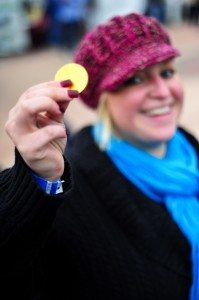 It used to be that you never uttered the C word or the F word in coin collecting; of course, those words would be counterfeit and fake, as in counterfeit and fake coins. Nowadays, many coin collectors use another term for these less-than-real coins that is a little more… ahem… politically correct, and that is “replica coins.”
It used to be that you never uttered the C word or the F word in coin collecting; of course, those words would be counterfeit and fake, as in counterfeit and fake coins. Nowadays, many coin collectors use another term for these less-than-real coins that is a little more… ahem… politically correct, and that is “replica coins.”
Novelty coins, replica coins, copy coins… No matter what term you use, though (even if it is fake coins!), collecting coins that aren’t 100 percent mint made is becoming somewhat of a fascination for thousands of coin collectors.
From crudely struck counterfeit coins to masterfully altered varieties, there is no shortage of fake coins out there, and a growing number of people who are glad to collect them.
What’s happened in the last number of years to draw some coin collectors to embrace fake coins?
It’s an area of interest that largely grew out from coin collectors and some coin dealers who would keep fake coins so they could study them and become more knowledgeable about how to detect others.
In some cases, there are varieties of coins that once were considered to be authentic only to be later discovered as altered or fake.
Micro O Morgan Dollars – Fake Coins That Even Fooled The Professionals
Probably the most notorious example of this would be the so-called micro O Morgan silver dollars. For decades, coin collectors believed there was a variety of Morgan dollars struck at the New Orleans mint that carried a smaller-than-usual O mintmark. The coins looked so real that even the third-party coin grading companies, such as the Professional Coin Grading Service (PCGS) were authenticating and slabbing them!
In fact, it wasn’t until PCGS received large amounts of these micro O Morgan dollars at one time that they began examining them even closer to determine if they were any fakes among the huge batch of supposedly scarce coins. As it turned out, they were all fake, and a study of other micro O Morgan dollars revealed the same.
While the micro O Morgan dollar coins were all very well made, another reason that they may have eluded detection as counterfeits was that they were made no later than the 1940s, so they had been part of the numismatic environment for many decades.
Years ago, it used to be that coins discovered to be fakes would be removed from reference books, like A Guide Book of United States Coins. However, as coin collectors today start to embrace fake coins as a branch of exonumia, many publishers are retaining the listings of these faked coins and noting as a footnote that a said piece was privately made.
Other Examples Of Fake Coins
A similar situation had occurred decades ago in the arena of many colonial and territorial coins that were once thought to be original varieties but, upon further inspection, turned out to be highly convincing fake coins. However, many of those coins lost their standing in the coin reference books of the day because, at the time, the very notion of fake coins would have made just about any numismatist shudder.
Yet, in some cases, there is a numismatically romantic allure to certain counterfeit coins. Take, for example, the 1883 Racketeer nickel. In case you’re wondering, that’s the name of certain 1883 Liberty Head nickels that were gold-plated. More specifically, nickels that were gold-plated by a man named Josh Tatum.
As the story goes, Tatum was a deaf mute who capitalized on the fact that the first 5.4 million 1883 Liberty nickels struck did not contain the words FIVE CENTS on the reverse — merely a big V (Roman numeral) to indicate its denomination. The coin’s obverse looked so much like the circulating $5 gold coin at the time, that Tatum believed he could get away with gold-plating hundreds of 1883 “no cents” nickels and pass them off as $5 gold coins.
His game? He would go into a store, buy an item that cost five cents, then hand the cashier one of his gold-plated 1883 coins without asking for change. Usually, his scheme would work, and the cashier would hand Tatum $4.95 in change. Eventually, the law caught up with Tatum. He was tried in court for fraud, but the charge was dismissed because he never actually asked for change and nobody could testify against him.
The story has long attracted thousands to collect gold-plated 1883 no-cents Liberty nickels, though how many can be traced back to Tatum is uncertain.




